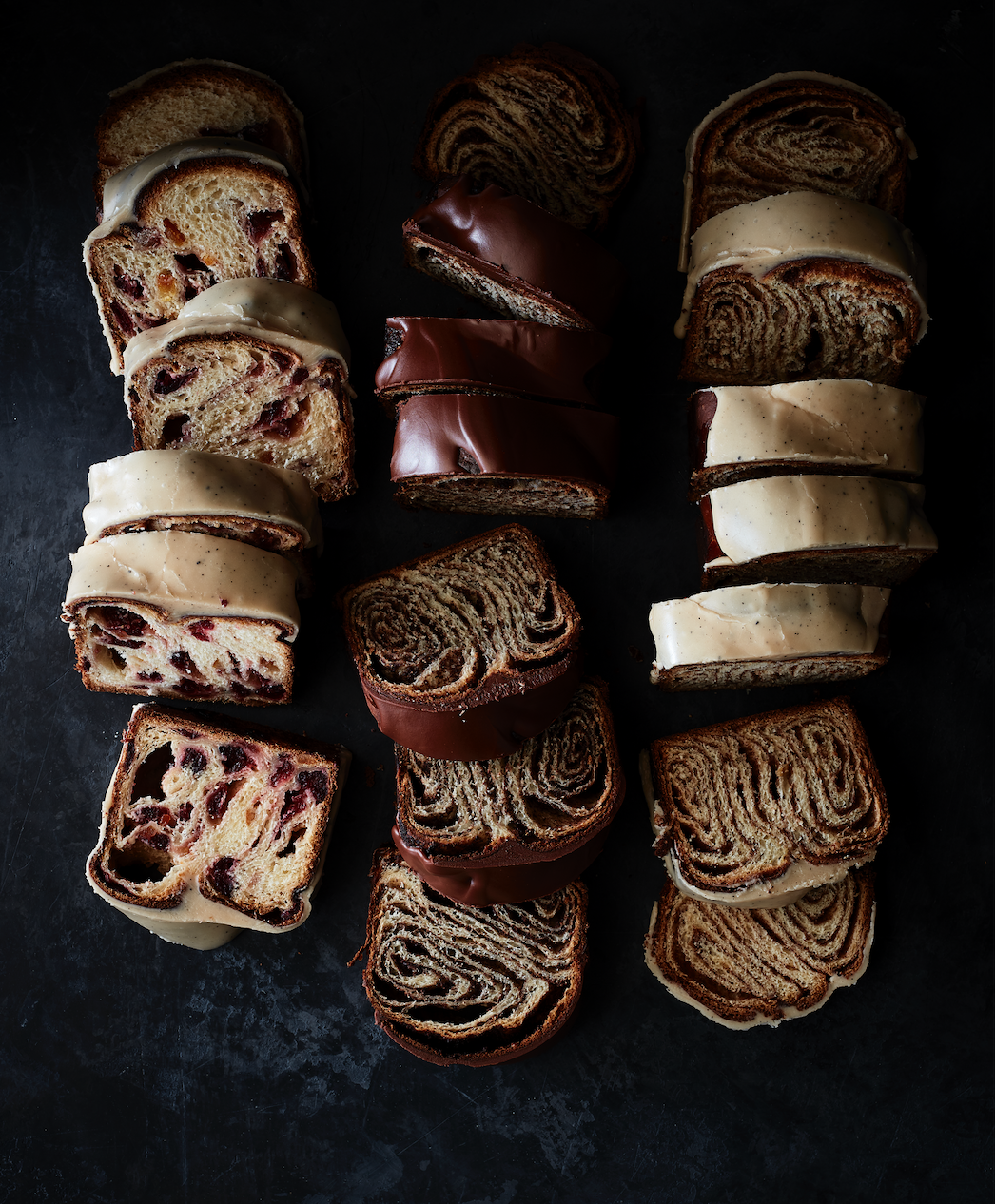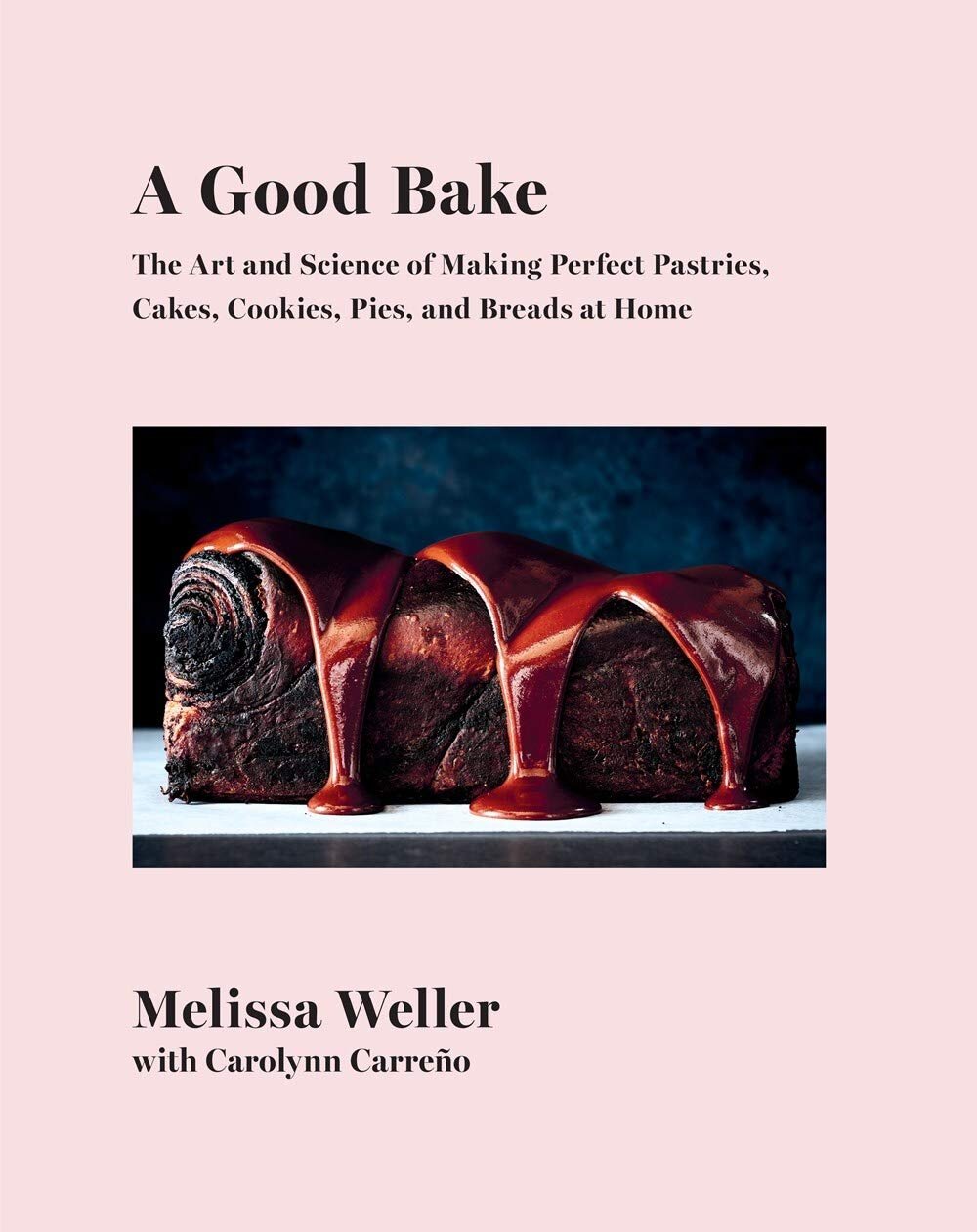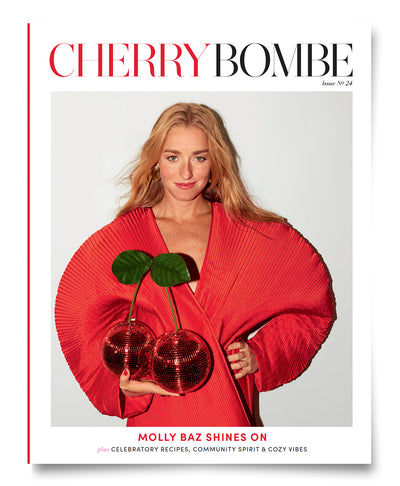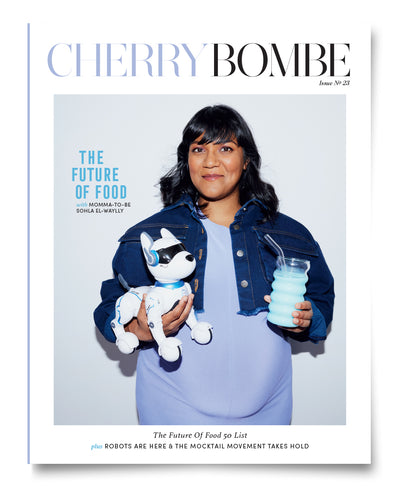Recipes
Melissa Weller’s Chocolate Babka
Makes 2 babkas
As pleased as I was when a slice of this babka ended up on the cover of Food & Wine magazine, for me, the real testament to my babka came when I brought a loaf with me when I went to eat at Zahav, an Israeli restaurant in Philadelphia. I brought the babka as a gift for the chef/owner, Michael Solomonov. I was a little nervous because Michael is an expert on Jewish food, but he loved it, and his staff loved it. And he confirmed that it was a traditional Ashkenazi babka. I top mine with a glaze rather than the traditional crumb topping, but otherwise, this is a classic.


Image Credits
Photo by Johnny Miller
ingredients
For the dough
- Babka Dough (recipe below)
For the filling
- 140 grams homemade chocolate shortbread or store-bought chocolate cookies
- 6 ounces/170 grams (1 cup chips) milk chocolate
- 2.5 ounces/71 grams (½ scant cup chips) bittersweet chocolate
- 9 tablespoons/127 grams (1 stick plus 1 tablespoon) unsalted butter, cubed
- 105 grams (⅓ cup) mild-flavored honey, such as wildflower or clover
For baking the babka
- 1 large egg (50 grams)
- Big pinch of fine sea salt
For the glaze
- 4 ounces/113 grams (⅔ cup chips) milk chocolate
- 4 ounces/113 grams (⅔ cup chips) bittersweet chocolate
- 8 tablespoons/113 grams (1 stick) unsalted butter
- 20 grams/1 tablespoon mild-flavored honey, such as wildflower or clover
- Note: You will need two 9-by 4-inch Pullman loaf pans or two 9-by 4-inch standard loaf pans to make this.
Method
- Make the filling: Put the cookies in a food processor fitted with a metal blade and process them to crumbs.
- Pour 1 to 2 inches of water into the bottom of a small saucepan and choose a bowl that fits over the saucepan to make a double boiler. Make sure the water is not touching the bottom of the bowl; if it is, pour some water out. Bring the water to a boil over high heat, then reduce the heat to medium-low to maintain a gentle simmer.
- If the chocolate for the filling or the glaze is in a chunk or bar, roughly chop it.
- Add the milk chocolate, bittersweet chocolate, and butter to the bowl of the double boiler and heat them until they melt, stirring occasionally with a heat-proof rubber spatula and scraping down any chocolate that collects on the sides of the bowl to make sure it melts evenly and doesn’t burn. Turn off the heat.
- Remove the bowl from the double boiler and wipe the bottom of the bowl to make sure no water drips. Add the cookie crumbs and honey, and stir to combine. Set the filling aside to cool slightly; you want it to be warm enough to be still spreadable. If you are making the filling in advance of the babka, allow it to cool to room temperature. If you are making the filling to assemble the babka another day, refrigerate it, covered, for up to 2 days. Warm it up in a microwave or a saucepan over medium-low heat, stirring often, before using. Divide the filling in half to use half for each babka.
- Fill, shape, proof, and bake the babkas: Remove the dough from the refrigerator. Lift up the parchment paper holding the top square of dough and lay it on a flat, floured work surface. Return the baking sheet with the remaining sheet of dough to the refrigerator.
- Roll the dough out into a 16-inch square with a floured rolling pin. Roll it from the center outwards, rotating the dough as you roll.
- Use an offset spatula to spread two-thirds of one portion of the filling evenly over the surface of the dough, taking care to spread the filling to the edges. Gently roll the dough away from you to form a fat roll. Pick the babka roll up with two hands and give it a gentle pull on both ends to elongate it slightly. Set the roll down and cut it in half through the middle so you have 2 rolls, each approximately 10 inches long.
- Spread the remaining portion of filling across the top of one of the 2 halves and place the second half on top of the filling to form an X with the 2 rolls of dough. Twist the ends of the bottom roll up and over the top roll to cover the filling. Pick up the babka with two hands and place it into a prepared loaf pan. Repeat, removing the second sheet of dough from the refrigerator and assembling the second babka using the remaining filling.
- Adding a layer of filling between the rolled babka dough helps keep the layers separate when the babka bakes, resulting in a more layered babka.
- Proof and bake the babkas: Cover each babka with a clean kitchen towel or plastic wrap and set it in a warm place to proof for 2 to 3 hours, until the loaves have doubled in size.
- Arrange the oven racks so one is in the center position. Preheat the oven to 350°F.
- Whisk the egg with the salt in a small bowl to make an egg wash. Uncover the babka loaves and brush the wash generously over their surfaces; discard the remaining egg wash.
- Place the babka loaves on the center rack of the oven to bake for 45 to 50 minutes, until they are deep golden brown, rotating the pans from front to back halfway through the baking time. Remove the babkas from the oven and set aside to cool for 5 to 10 minutes, until they are cool enough to touch. Place a clean kitchen towel on the counter and flip the babkas upside down to release them from the pans. Place them, right side up, on a cooling rack to cool slightly.
- Make the glaze and glaze the babkas: While the babkas are baking, pour 1 to 2 inches of water in the bottom of a small saucepan and choose a bowl that fits over the saucepan to make a double boiler. Make sure the water is not touching the bottom of the bowl; if it is, pour some water out. Bring the water to a boil over high heat, then reduce the heat to medium-low to maintain a gentle simmer.
- If the chocolate is in a chunk or bar, roughly chop it. Place the milk chocolate and bittersweet chocolate in the bowl of the double boiler. Add the butter and honey and warm them until they melt, using a heat-proof rubber spatula to stir and scrape down the sides of the bowl so the chocolate doesn’t burn. Remove the bowl from the double boiler and set it aside to cool the glaze slightly.
- Remove the babka loaves from the oven and set them aside to cool for 5 to 10 minutes, until they are cool enough to touch. Place a clean kitchen towel on the counter and flip the babkas upside down to release them from the pans. Place them right side up on a cooling rack to cool slightly. Spoon the warm glaze over the top of the babkas while they are still warm. Wait for the glaze to set before slicing the babka, about 20 minutes.
Divider
Babka Dough
There is nothing difficult about making babka, but what it does require is time. You do have to let the dough ferment, which develops its flavor. Then, because it contains so much butter, the dough must be chilled before it is rolled out and formed, otherwise it will be too sticky to work with. Then once it is filled and shaped, it has to proof, which gives it its lift and lightness. These steps take time. Although in theory babka could be made from start to finish in one day, for practical purposes, when I make babka at home, I spread the project out over two days.This recipe makes enough for two babka loaves. If you don’t want to make both loaves at once, refrigerate the second half of the dough for up to 3 days before you make your second loaf.Makes enough for 2 babkas

Photo by Johnny Miller
ingredients
3¾ cups (450 grams) all-purpose flour, plus more for dusting½ cup (100 grams) granulated sugar
1 tablespoon (9 grams) instant yeast
2 teaspoons (12 grams) fine sea salt
1 cup (240 grams) whole milk
1 large egg (50 grams)
1 large egg yolk (17 grams)
10 tablespoons (141 grams) Kerrygold Unsalted Pure Irish Butter, cubed and softened
Nonstick cooking spray
method
Make the dough: Combine the flour, sugar, yeast, and salt in a large bowl and stir with a whisk to combine the ingredients.Place the milk, egg, and egg yolk in the bowl of a stand mixer. Fit the mixer with the dough hook and add the dry ingredients. Mix on low speed for 3 minutes to create a homogenous dough. Increase the speed to medium and mix for 5 to 8 minutes, until the dough is completely wrapped around the hook and cleans the sides of the bowl. With the mixer still running on medium speed, add the butter and mix on medium speed until the butter is completely mixed in and no butter chunks remain, 5 to 10 minutes, stopping to wipe the dough hook clean once or twice with a wet hand. (The time will depend on the softness of the butter.) Turn off the mixer. Ferment the dough: Remove the bowl from the mixer and wipe the dough hook clean with a wet hand. Cover the bowl with a clean kitchen towel or plastic wrap and set it in a warm place to allow the dough to ferment for 2 hours, turning the dough after 1 hour. To turn the dough, uncover the bowl and use a wet hand to fold the top edge down two-thirds and fold the bottom edge to meet the top edge, so the dough is folded like a letter. Fold the sides inward in the same way to form a sort of ball, then re-cover the bowl. Line a baking sheet with parchment paper and generously spray with nonstick cooking spray.Lightly dust a large flat work surface with flour. Uncover the bowl and transfer the dough to the floured work surface. Use your hands or a bench knife to divide it in half. (Each half will be approximately 500 grams.)Place the dough on the prepared baking sheet and use your hands to gently coax and pat the mound or mounds of dough into even squares. Put the baking sheet in the refrigerator to chill the dough for at least 2 hours, until it feels firm. (If you are making the dough in advance, remove the baking sheet from the refrigerator after 2 hours, wrap the baking sheet in plastic wrap so the dough doesn’t dry out and develop a skin, and return it to the refrigerator for up to 2 days.)Note
Wrapping dough in plastic after it is chilled prevents it from sticking to the plastic wrap.Links
| Title | Don’t miss melissa’s Book! |
| Image |
 |
| Button | GET YOUR COPY |
| Description | If you order from our website, please note, some of the items we link to may earn us a small commission. |
| Description | Excerpted from A Good Bake: The Art and Science of Making Perfect Pastries, Cakes, Cookies, Pies, and Breads at Home by Melissa Weller with Carolynn Carreño. Copyright © 2020 by Melissa Weller. Excerpted by permission of Alfred A. Knopf, a division of Penguin Random House LLC. All rights reserved. No part of this excerpt may be reproduced or reprinted without permission in writing from the publisher. |






